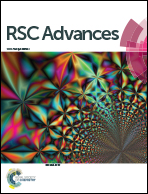Prediction of large magnetoelectric coupling in Fe4N/BaTiO3 and MnFe3N/BaTiO3 junctions from a first-principles study†
Abstract
The magnetoelectric (ME) effects of Fe4N/BaTiO3 and MnFe3N/BaTiO3 junctions are investigated using first-principles calculations. Compared with the very weak ME coupling effects for FeN/TiO2 interfaces in both Fe4N/BaTiO3 and MnFe3N/BaTiO3 junctions, the large ME coefficients are achieved at the more stable Fe2/TiO2 interface in the Fe4N/BaTiO3 junction and the more stable MnFe/TiO2 and Mn2/TiO2 interfaces in the MnFe3N/BaTiO3 junction. The magnetoelectric effect originates from the interface bonding mechanism which alters the chemical bonding and the hybridization at the interface when the electric polarization reverses. In addition, from the detailed analysis, we find that the interfacial FeII(MnII) (the face-centered sites Fe or Mn in Fe4N and MnFe3N) atom plays a more important role in the ME coupling than the interfacial FeI(MnI) (the corner sites Fe or Mn in Fe4N and MnFe3N) atom. These results suggest that Fe4N/BaTiO3 and MnFe3N/BaTiO3 junctions could be designed as multiferroic materials with large magnetoelectric coupling under their more stable interfaces. And the magnetic Mn-substitution doping at the interfacial FeII position in the Fe4N/BaTiO3 junction can possibly obtain a relatively large ME coefficient difference compared with doping at the interfacial FeI position.


 Please wait while we load your content...
Please wait while we load your content...